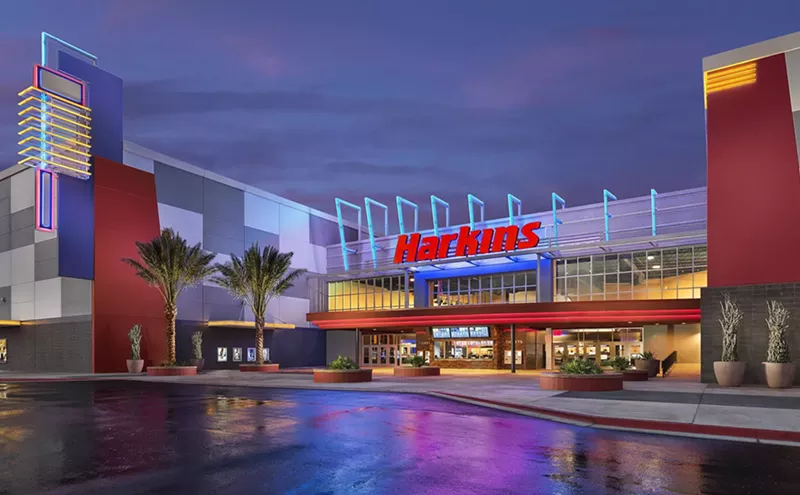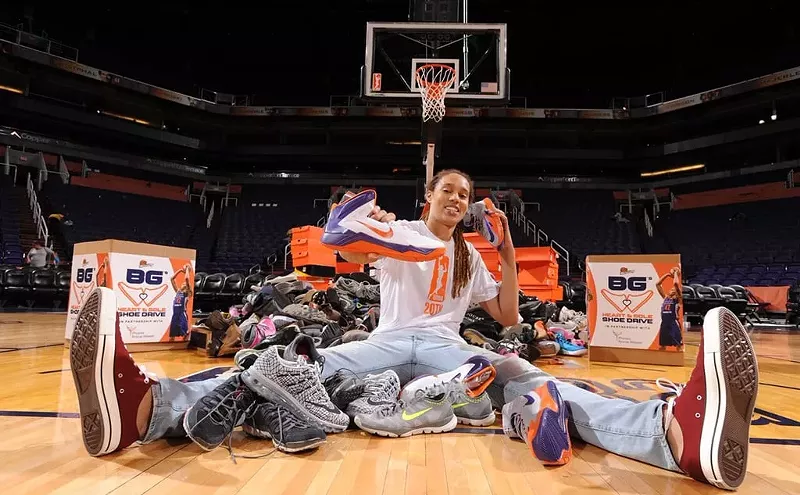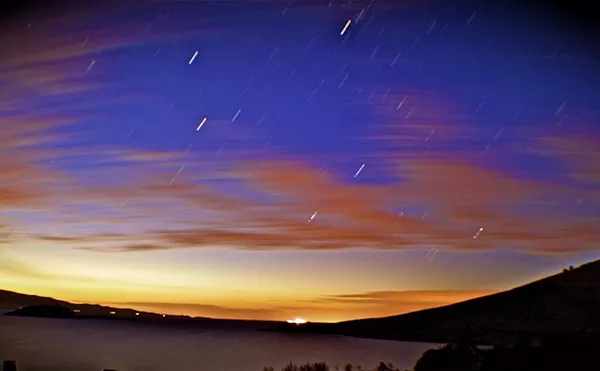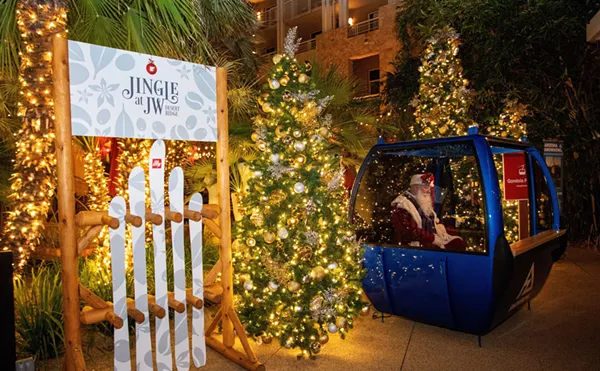For more of the best people, places and things to do in Phoenix, check out our 2015 Best of Phoenix awards.
Jason Rose is not a runner. There's no indication that he's particularly fond of the heat. But the notorious, big-haired public relations executive knows a sweat-drenched stunt when he sees one, and that's how Scottsdale got saddled in 2013 with Beat the Heat, a running event marketed as "The Hottest Race on Earth."
Known for trotting out Joe Arpaio to sell pink underwear at the unfortunately named Pink Taco restaurant, and shilling for politicians like Andrew Thomas and causes like medical marijuana, Rose created the race in an answer to a question raised at a meeting with the Scottsdale tourism board: "How do you market Scottsdale in the summer?"
Not being a runner himself and having never hosted an event of such an extreme nature before, Rose turned to professionals for help — ultramarathoner Perry Edinger and Raceplace Events president Chris Giles — and set up the course at WestWorld, the same venue that hosts Rose's Polo Championships and Rugby Bowl.
Beat the Heat was designed to commemorate the hottest day in recorded Phoenix history: 122 degrees at 2:47 p.m. on June 26, 1990. Though Rose couldn't match the exact date — June 26 didn't fall on a Saturday in 2013 — he did his best to drive home the point in other aspects. The starter's gun was fired at the same time as the historic high had been recorded: 2:47 p.m. The initial course was tailored solely for an 11.22K run to mark the targeted temperature — though an additional 5K option was added later in the registration process to appeal to more runners.
To up the attendance of elite and out-of-state runners, Rose offered prize money — as much as $1,999 — to the top 10 finishers. The event was geared to deliver what runners hoped to brag about and the media hoped to cover: strong competition, serious challenge, and the possibility of a cautionary tale in the end.
As it turns out, this was not a completely original idea.
The concept of making Arizona's biggest drawback an attractive feature slowly has gained momentum with other Valley organizations. For two recent summers, the Hotel Palomar in downtown Phoenix hosted Sweat Your Asana, a poolside community yoga glass that used summer temperatures to take stretching to a new level.
This past June, Tempe Bicycle Action Group continued its long-established annual Solstice Ride, a shenanigans-infused guerrilla ride complete with water balloon fights, Slip 'N Slides, and an after-party.
In August, State Bicycle Co. co-founder Mehdi Farsi successfully carried out his second annual Hell Ride, a non-competitive, ride-at-your-own-risk event that drew roughly 60 cyclists of all ages — the youngest was 12 — for an eight-mile ride at noon to the top of South Mountain.
"I think the heat is very distinctively an Arizona desert type of thing," Farsi says. "You couldn't pull this event off in Colorado or somewhere else. We see all these cool events in New York that are distinct to New York. We see cool events in L.A. that are distinct to L.A. We wanted to do something that was kind of distinct to where we are from."
But it's not just Arizona. These limit-pushing activities have become prominent around the country and across the globe.
Since 1987, California has been home to the "world's toughest foot race," the 135-mile Badwater ultramarathon that takes participants from Death Valley to Mount Whitney, spanning three mountain ranges, beginning at 280 feet below sea level and finishing at an elevation of 8,300 feet. The annual race consists of as many as 100 athletes from all over, ranging in age from 19 to 70. This year's Badwater featured 97 runners, 79 of whom finished, including winner Pete Kostelnick who crossed the finish line with a time of 23:27:10.
Other extreme environment races include the Marathon des Sables, a six-day ultramarathon in the Sahara Desert, as well as the sub-zero North Pole Marathon and its equally challenging polar opposite, Antarctic Ice Marathon.
Just because something is trending doesn't necessarily mean it's good for you. Dr. Bill Mostow, medical director of the ER department at Banner Del E. Webb Medical Center in Sun City West, has seen his fair share of heat-related injuries in the Valley.
"It might be a fun challenge and a kind of gratifying thing and wacky thing to get up there and show how much pain you can tolerate and how you can withstand the heat, but you shouldn't fool yourself into thinking that it's good for you," he says.
Last year, Maricopa County's public health department reported 58 heat-associated deaths in the United States, 54 of which occurred in Arizona. While 43 percent of those were aged 65 and older, and 38 percent had drugs or alcohol mentioned on their death certificates, Mostow notes that it's not the just the vulnerable and elderly that are susceptible to the heat.
"Even if you're in shape, it can sneak up on you. You can be out in the elements doing your thing and thinking you're doing great and then all of a sudden you find yourself in a little bit of trouble, and that's where the real danger is, I think."
Mostow agrees that, to an extent, people can adapt to certain bodily stresses and that some individuals have better internal cooling systems than others, but ultimately these factors can only get you so far.
Mostow explains that when the human body becomes overheated, the internal thermostat begins to falter. In addition to the more familiar symptoms of nausea and confusion, extreme heatstroke victims eventually can lose the ability to sweat, raising the temperature of their internal organs to such a degree that they start to fail.
"It's a little more complicated than this metabolically, but basically you are cooking on the inside," says Mostow.
Other than utilizing common sense precautions such as staying hydrated, having an electrolyte solution on hand, and implementing some sort of cooling mechanism, Mostow advises that we take heed from the more native habitants around us.
"We've only gotten to the desert pretty recently, and there are desert animals that have been out here for hundreds, thousands of years, and none of them exercise in the heat," Mostow says. "Our best bet is to live like the desert animals around us. That is, to come out at night and to stay in the shade during the summer months."
But modern-day Phoenix seems to be breeding a new form of desert animal, one that's not only surviving the heat but thriving in it. Cheman Cuan, a recent Arizona State University graduate and two-time Hell Ride cyclist, is such a creature.
While most people are doing their best to dodge the desert heat, getting up in the wee hours of the morning to ride or run, Cuan is embracing it. During the summer months, the 22-year-old averages anywhere from 100 to 250 miles a week, alternating between road and mountain biking, never hitting the trails earlier than 10 a.m.
Not one for early wake-up calls and indoor exercise, Cuan finds two benefits of exercising in extreme temperatures: less traffic on the trails and more opportunity to take his tolerance to the next level.
Though his training schedule is alarming to some, including his mother, who insisted Cuan consult a doctor about the dangers of his heat-seeking activities, he feels that it's all about acclimating. "Just as people do well in the cold weather, people can be fine in the heat, too," he says.
Indeed, when it comes to the heat, some people are more than fine — they're damn near fanatical. Take Brooke Sterling, longtime yogi and owner of Bikram Yoga Phoenix.
Diagnosed with cystic fibrosis as a child, Sterling uses the Bikram heat as a way to open her lungs and flush her endocrine system.
"In its most basic nature, the heat is a catalyst," Sterling says. "The heat speeds things up: mental processes speed up, detoxification processes speed up. Heat can accelerate. So if you can slow your breathing down, slow your movements down, you can work effectively with it."
Sterling does acknowledge the potential dangers that come with exercising in a 105-degree room for 90 minutes. As with any sweat-spilling sport, she advises common sense precaution.
"I do think the heat in a Bikram class is therapeutic by design but has to be used intelligently none the less," Sterling says. "Big variables that people forget, myself included, [are] sleep, nutrition, [drinking] four liters of water, [replacing] your electrolytes, and also how connected you are to your breath when you walk into the room. That will have the most enormous impact on the experience, above all the variables."
Breathing, Sterling explains, gives practitioners the ability to control their heart rate and stay in tune with what their body is telling them: ease up, keep going, take a break.
You'd be hard-pressed to find the benefits of competing in Scottsdale's Beat the Heat. Running on its own, sure. But running in triple-digit temperatures? Not likely.
By the time the gun for the inaugural Beat the Heat was fired on June 22, 2013, the temperature had hit 104 degrees and the number of registered participants totaled 1,348.
Runners came from 22 states and countries and included the likes of Olympians Nahom Mesfin, who won the 11.22K race with a time of 00:35:34, and Andrew Lemoncello, who took second place at 0:35:47.
Jason Rose credits the success of Beat the Heat to a combination of "uniqueness, audacity, and achievement."
"People want to challenge themselves," he says.
Rose came prepared with waivers, insurance policies, three ambulances, and 26 emergency personnel. Racers were offered water through the course, sprinklers were turned on, the Scottsdale Fire Department was on site to spray down passersby.
Still, there were minor casualties.
Event paramedics told the press that three people in total had to be treated for cramps, dehydration, and heat exhaustion. "Heat exhaustion," Rose the PR exec points out, "not heatstroke."
Two of the three were taken to nearby hospitals for treatment.
Rose admits that competitors had their complaints — about the layout of the course, the design on the T-shirts. But when asked if anyone had negative feedback about the heat itself, Rose says no. "People knew what they were getting into."
In fact, Rose thinks extreme events like Beat the Heat are the future of this kind of competitive sport. He says there's plenty of room for growth.
Cool your heels, runners. There hasn't been another Beat the Heat since 2013 — and no firm plans for one in the future.












